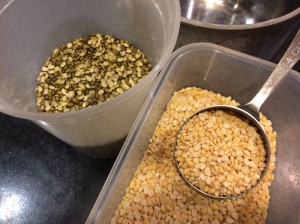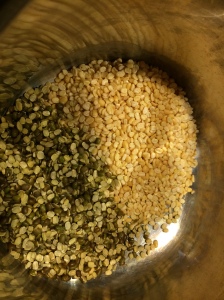Very little meat is eaten in India; many families are entirely vegetarian, but even the others (like mine) hardly got around to buying meat for the dinner table once or twice a month. I have met a lot of people in the United States who find that hard to believe. In this country all three meals are sometimes centered around meat. In addition to forming the main course, meat products are used to flavor the food: whether it is the use of chicken broth, or bacon cooked into the sauce base or thrown on salad, or ham hocks as a base for tough greens like collards.
Many modern cooks here are learning to leave aside the bacon in favor of aromatics like onion and garlic. In my mother-in-law’s generation people were a little afraid of these ‘strong’ and ‘aggressive’ flavors; nowadays, they generally lead to a flurry of swooning.
But what if you were to leave out the meat, leave out the eggs, then in a fit of pique throw out the onions and garlic too?
What would food taste like then? Is one supposed to develop a taste for grass? Well it turns out that this type of cuisine is one of the most flavorful in the world. Jain food, which is pretty much synonymous with the Sattvic or ‘pure’ food of Hinduism, leaves out any foods that might cause harm to other creatures; clearly this is an extremely high bar, but in practice, that means no meat, eggs, fish, onions or garlic.
That still leaves the wide world of vegetables (including my beloved cauliflower), all kinds of lentils (dals), grains from wheat and rice to millet and sorghum, the nutty fragrance of ghee, and of course what India is famous for, which is spices.
Tempering
My personal opinion — the ingredients are great and all. But really what sets apart Sattvic cuisine and Indian cuisine in general is the technique of tempering. Known by various names — tadka, chhaunk, bhagaar or vaghaar — this is the method of heating fat and throwing in whole spices until they release their essential oils.
Most non-Indian people ask me if I grind my own spice mixtures for Indian food. The answer is yes, I do. But for most everyday food, I don’t need to — because I just use them whole while tempering.
This is the basic process of tempering. Heat oil or ghee in a thick-bottomed small pan. When it shimmers (in case of ghee it should completely melt and a fragrance arise) the spices are put in. There is a certain sequence to the introduction of spices to the oil. There is, I admit, a bit of magic to this. Asafetida, if it is used, usually goes in first. Dry red chilies, if used, go in next. Mustard seeds (for me) usually go in last because they will pop with a vengeance. In between come the other whole seeds. Then in go the aromatic vegetables, such as garlic, ginger, chilies, onion, if any, that the recipe demands.
Tempering can be the first step of the recipe. Or it could be the last, as in the one below. The tempered oil is poured over the completed dish and stirred in.
Now spices are great even if you prepare them in the more well-known way — which is to grind them up into a mixture. I’m not going to run this method down (a classic of many cuisines, including Indian) but here is the difference from the tempering method. When you grind the spices, you are pulverizing every bit of them into the food. This includes the essential oils but also the fibrous seed-coating and other parts. Yes, there is a bit of the cardboard taste in most of the fibers. When you have a strongly flavored meal with onions or meat and so forth, you don’t notice this powderiness. But in a delicately flavored dish where the highlight is a lentil or a vegetable, the ideal method is to draw out the spice flavor into fat, leave the seeds whole where they add a bit of crunch, leaving the tastes pure.
And if you think about it, purity is what the Sattvic type of food is centered on.
Moong dal tempered with whole spices
This dish uses a mix of the dehusked (yellow) moong dal and the split but skin on (green) moong dal. Moong dal, of course, is a synonym of mung bean. It is one of the fastest cooking dals and needs no pre-soaking. This makes enough for a dinner for two.
Ingredients:
- 1/2 cup moong dal split and dehusked
- 1/4 cup moong dal split but with skin on
- 1/2 teaspoon turmeric
- 1/2 teaspoon asafetida (hing)
- 1/2 teaspoon red chili powder
- 1/4 teaspoon ajwain (carom) seeds
- 1 teaspoon cumin (jeera) seeds
- 1 teaspoon black mustard (rai) seeds
- 1 teaspoon salt
- 2 tablespoons oil
- 2 cups water
- For garnish: dry mango powder or lemon juice, more red chili powder, minced cilantro.
Method:
Rinse and drain the mix of dals in plenty of water. Put the dal in a pot along with 2 cups water and the turmeric. Bring it to a boil with the lid off; once it foams up heartily you can lower the heat to a simmer, partially cover with a lid and leave it for 35 to 45 minutes. At this point it should be softened. Add the salt.
Heat the oil in a thick-bottomed pan. When it shimmers add the asafetida and the red chili powder; when they foam add the cumin and the carom seeds; when they sizzle add the mustard seeds; when they pop turn off the heat and pour the oil into the dal.
Stir and taste for salt. At this point your dal is ready, all that is left is the garnish. I have suggested some but feel free to experiment!












I’m curious if you have opinions about which oils to use, taste vs health and heating etc…
LikeLike
PS I thought this was an interesting post on mustard oil, including the comments (to which I contributed a question) http://agardenerstable.com/2013/12/29/mustard-oil-for-external-use-only/ x
LikeLike
About oils…that will have to be another post, maybe another experiment. But in short: for regular cooking, I use pure olive oil (not xtra virgin) because of the high heat of sauteing. For recipes where I want a certain mildness, or sweetness, or purity, call it what you will, I use ghee. I love ghee. And for the ones where I want a kick, I use mustard oil. Thanks for that link. It was very enlightening and I followed that blog.
LikeLike
I agree, there is such magic in the tempering. Onions and garlic are not needed at all.
LikeLike
It is very subtle…I feel like I have a lot to learn about tempering. Let me know if you have instructions about it on your blog.
LikeLike
Oh, I think that you captured it perfectly! I think that Indian food is about the spices, and any other ingredients are just a medium for carrying the spice flavours.
About oils, I use ghee for most Sth Indian cooking, sometimes coconut oil for Indian West Coast recipes, sometimes Indian sesame oil, and a touch of mustard oil for some Nth Indian. But nothing really beats the taste of ghee. I use it in abundance.
Olive oil I save for cooking western dishes.
Thank you for your lovely posts.
LikeLike
I am going to try this tonight
LikeLike
Hey there let me know how it went.
LikeLike
Looks awesome!
LikeLike
I’ve always had trouble when adding red chili powder to oil while tempering. It makes a lot of smoke and makes me cough. Maybe I should use more oil like you have shown. And maybe add it in the end?
LikeLike
Adding it in the end works. But I do add it first often, along with the asafetida. I think that it doesn’t make too much smoke if you add it before the oil has become really hot. But you are right, sometimes I miss the moment causing smoke and coughing and opening of windows.
LikeLike
I really do love dhal. I’ve bookmarked this to have a go at too.
Please excuse my ignorance, but why are onions and garlic avoided? I understand the no meat and fish part, but the alliums have me a little baffled.
LikeLike
I’m not sure I know the real reason either. I had always heard that it is because one has to pull it out by its roots and therefore it kills the plant (i.e., violence). But recently I read somewhere that it is because they didn’t like how strong and aggressive those flavors are. I hope someone who knows the real reason will respond to this comment.
LikeLike
Have you tried Black Beluga Lentils? Of late I am obsessed with these lentils, and have used this in all my dhaal recipes.
LikeLike
Care to share a recipe?
LikeLike
yumm anila… love ur posts
LikeLike
Thanks Lata…will catch up with you on facebook.
LikeLike